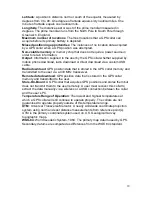
18
Latitude
: A position's distance north or south of the equator, measured by
degrees from 0 to 90. One degree of latitude equals sixty nautical miles. One
minute of latitude equals one nautical mile.
Longitude
: The distance east or west of the prime meridian measured in
degrees. The prime meridian runs from the North Pole to South Pole through
Greenwich, England.
Maximum number of locations
: The most locations that a GPS collar can
acquire before its primary battery is depleted.
Missed positioning opportunities
: The instances of no location data acquired
by a GPS collar when a GPS position was attempted.
Non-volatile memory
: A memory chip that does not require a power source in
order to retain information.
Output
: Information supplied to the user by the GPS collar whether supplied by
mobile phone download, radio download or direct download via a custom USB
cable.
Radio download
: GPS position data that is stored in the GPS collar memory and
transmitted to the user via a 433 MHz transceiver.
Remote data download
: GPS position data that is stored in the GPS collar
memory and transmitted to the user.
Store-On-Board
: A GPS collar that acquires GPS positions and stores them but
does not transmit them to the user remotely. A user must recover this collar to
extract the data manually via a wireless or a USB connection between the collar
and the user’s PC.
Temperature Range of Operation
: The lowest and highest temperatures at
which a GPS collar will still continue to operate properly. The collars are not
guaranteed to operate properly outside of this temperature range.
UTM
: Universal Transverse Mercator. A nearly worldwide coordinate projection
system using north and east distance measurements from reference point(s).
UTM is the primary coordinate system used on U.S. Geological Survey
topographic maps.
WGS-84
: World Geodetic System, 1984. The primary map datum used by GPS.
Secondary datums are computed as differences from the WGS 84 standard.

































